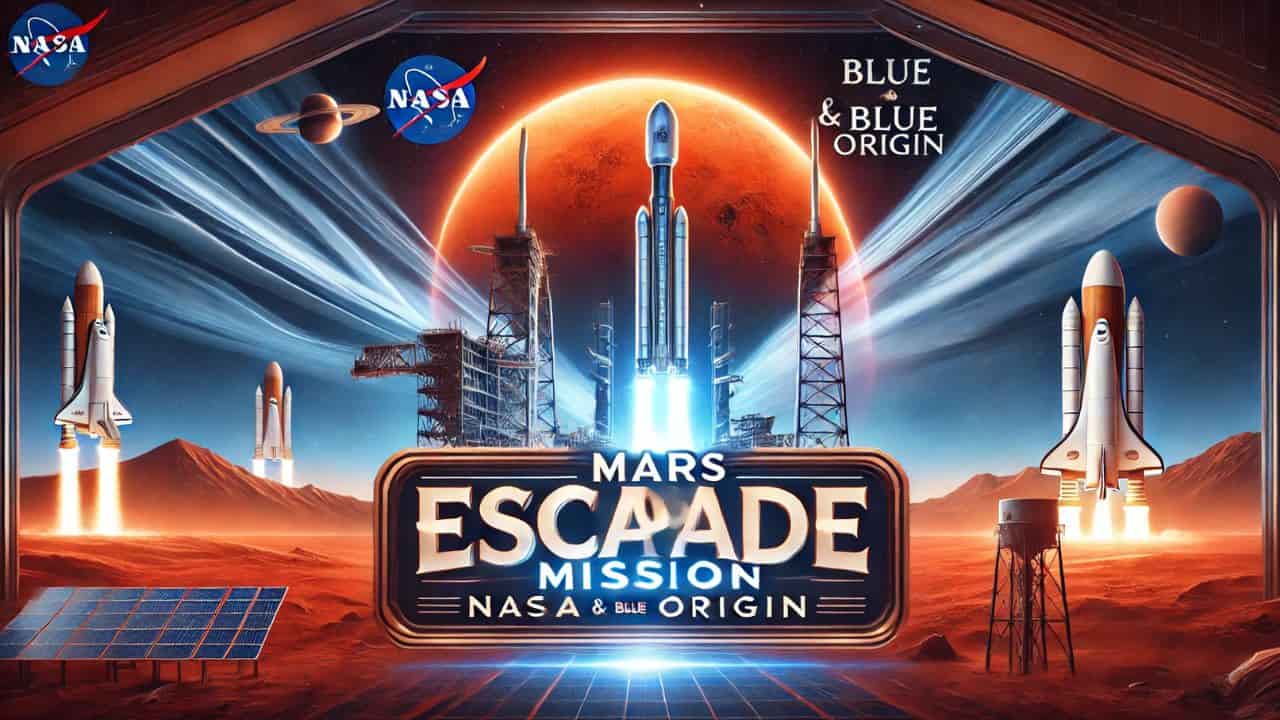NASA Mars mission, Blue Origin New Glenn, ESCAPADE mission, Mars solar wind interaction, Mars magnetosphere, Mars atmospheric escape, NASA space exploration, New Glenn rocket launch, space missions 2024, Mars exploration
Discover the upcoming NASA and Blue Origin ESCAPADE mission, launching on the New Glenn rocket, aimed at studying Mars’ solar wind interaction and magnetosphere. Learn how this groundbreaking mission could unlock the secrets of Mars’ atmospheric history.

NASA and Blue Origin Prepare for Landmark Mars Mission with New Glenn Rocket
In a significant stride towards exploring the mysteries of the Martian atmosphere, NASA and Blue Origin are gearing up for the launch of the ESCAPADE (Escape and Plasma Acceleration and Dynamics Explorers) mission. This mission, which marks the inaugural flight of Blue Origin’s New Glenn rocket, is set to study the intricate interactions between solar wind and Mars’ magnetosphere. The launch is scheduled for no earlier than Sunday, October 13, from Space Launch Complex 36 at Cape Canaveral Space Force Station in Florida.
The Mission’s Purpose and Significance
The ESCAPADE mission is designed to unravel the complex dynamics between solar wind and the hybrid magnetosphere of Mars. Understanding this interaction is crucial, as it plays a significant role in driving atmospheric escape from the Red Planet. Atmospheric escape is a process where particles in a planet’s atmosphere gain enough energy to overcome gravitational pull and escape into space. Over time, this phenomenon has contributed to the thinning of Mars’ atmosphere, which once may have supported liquid water and, potentially, life.
This mission will utilize two identical spacecraft to conduct its investigations. By studying the interaction between solar wind and the Martian magnetosphere, scientists hope to gain insights into the broader atmospheric processes that have shaped Mars over billions of years. This information could provide clues about the planet’s past, its potential for habitability, and how solar wind affects other celestial bodies.
The Role of New Glenn in Space Exploration
The ESCAPADE mission is not only important for the scientific data it aims to gather but also for being the maiden flight of Blue Origin’s New Glenn rocket. Named after astronaut John Glenn, the first American to orbit Earth, the New Glenn rocket represents a new chapter in commercial spaceflight. It is designed to be a heavy-lift orbital launch vehicle capable of carrying a variety of payloads into space.
New Glenn is an ambitious project by Blue Origin, a company founded by Amazon’s Jeff Bezos. The rocket is notable for its reusability, a feature that could significantly reduce the cost of space exploration. The successful launch and operation of New Glenn will not only validate its design but also set the stage for future missions, potentially making deep space exploration more accessible and sustainable.
Media Coverage and Accreditation
As the launch date approaches, media interest in the ESCAPADE mission and New Glenn’s debut is expected to be high. To accommodate this, NASA and Blue Origin have established a media accreditation process. U.S. media and U.S. citizens representing international media must apply by 5 p.m. EDT on Monday, September 30. Meanwhile, international media without U.S. citizenship must apply by 5 p.m. on Tuesday, September 10.
Media representatives wishing to cover the event are required to submit their accreditation requests online through NASA’s media portal. This process ensures that only credentialed journalists gain access to the launch site, maintaining both security and a focused environment for coverage. The accreditation process is a standard procedure for NASA missions, reflecting the significance of the ESCAPADE mission and the New Glenn rocket launch in the broader context of space exploration.
ESCAPADE Mission Partners and Contributions
The ESCAPADE mission is a collaborative effort involving multiple organizations. It is funded by NASA’s Heliophysics Division, which oversees research aimed at understanding the Sun and its interactions with Earth and the solar system. The mission is part of the NASA Small Innovative Missions for Planetary Exploration (SIMPLEx) program, which seeks to advance scientific exploration through smaller, cost-effective missions.
The University of California, Berkeley’s Space Sciences Laboratory leads the ESCAPADE mission. This laboratory has a rich history of space exploration and research, contributing to numerous missions that have expanded our understanding of the cosmos. Rocket Lab, an American aerospace manufacturer, and small satellite launch service provider is responsible for designing the spacecraft. Rocket Lab has gained recognition for its innovative approach to building and launching small satellites, and its involvement in ESCAPADE underscores its growing role in space exploration.
NASA’s Launch Services Program (LSP), based at Kennedy Space Center, is tasked with securing the launch service for ESCAPADE. This program plays a critical role in ensuring that NASA missions reach space safely and efficiently. For the ESCAPADE mission, the LSP utilized the Venture-class Acquisition of Dedicated and Rideshare (VADR) contract, which supports the procurement of commercial launch services for smaller payloads.
The Broader Impact of ESCAPADE and New Glenn
The ESCAPADE mission is poised to contribute significantly to our understanding of Mars and its atmospheric dynamics. By studying how solar wind interacts with the planet’s magnetosphere, scientists hope to gain new insights into how Mars lost much of its atmosphere over time. These findings could have implications not only for understanding Mars’ history but also for future exploration efforts, including the search for signs of past or present life.
Moreover, the successful launch of New Glenn will mark a milestone in the development of commercial spaceflight capabilities. Blue Origin’s commitment to reusability and cost-effectiveness could revolutionize how we approach space exploration, making it more sustainable and accessible. As New Glenn begins its journey into space, it will carry with it the hopes of scientists, engineers, and space enthusiasts around the world.
The Future of Mars Exploration
The ESCAPADE mission is part of a broader effort to explore Mars, a planet that has captivated human imagination for centuries. NASA has been at the forefront of Mars exploration, with missions like the Mars rovers and orbiters providing valuable data about the planet’s surface and atmosphere. ESCAPADE adds a new dimension to this exploration by focusing on the interaction between solar wind and the magnetosphere, a key factor in understanding Mars’ climate and atmospheric history.
Looking ahead, Mars exploration will likely continue to be a major focus for NASA and other space agencies. The data gathered by ESCAPADE could inform future missions, including those aimed at landing humans on Mars. As we learn more about the Red Planet, we move closer to the day when humans might set foot on its surface.
Conclusion
NASA and Blue Origin’s ESCAPADE mission, set to launch aboard the New Glenn rocket, represents a significant milestone in our quest to understand Mars and the broader solar system. By studying the interaction between solar wind and the Martian magnetosphere, ESCAPADE will provide valuable insights into the planet’s atmospheric history and its potential for supporting life. At the same time, the launch of New Glenn marks a new era in commercial spaceflight, with Blue Origin positioning itself as a key player in the future of space exploration.
As the October 13 launch date approaches, the eyes of the world will be on Space Launch Complex 36 at Cape Canaveral. For NASA, Blue Origin, and the many scientists and engineers involved in the ESCAPADE mission, this launch represents the culmination of years of hard work and dedication. And for the rest of us, it offers a glimpse into the future of space exploration—a future where missions like ESCAPADE help unlock the secrets of our solar system and pave the way for human exploration of Mars and beyond.
This mission is more than just a scientific endeavor; it is a testament to human curiosity and our relentless pursuit of knowledge. As New Glenn soars into the sky, carrying the ESCAPADE spacecraft on its journey to Mars, it will symbolize our unyielding drive to explore the unknown and expand the boundaries of human achievement.
Read More
- NASA and Sierra Space Dream Chaser Arrives in Florida for Launch Prep
- NASA Citizen Scientists Discover Hypervelocity Star Escaping Milky Way at 1 Million MPH
- NASA Issues Warning About 88-ft Airplane-Sized Asteroid Approaching Earth – Key Details Revealed
- SpaceXs New Falcon 9 Booster Successfully Launches 22 Starlink Satellites Boosting Global Connectivity










